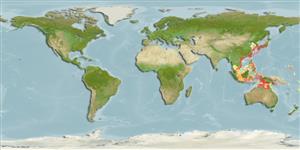>
Eupercaria/misc (Various families in series Eupercaria) >
Labridae (Wrasses) > Bodianinae
Etymology: Choerodon: Greek, choiros = a pig + odous = teeth (Ref. 45335); referrring to the prominent anterior canines of the species in this genus (Ref. 116605).
More on authors: Jordan & Snyder.
Environment: milieu / climate zone / depth range / distribution range
Écologie
marin récifal, usually 8 - 50 m (Ref. 27115). Subtropical; 23°C - 28°C (Ref. 27115)
Western Pacific: southern Japan, Korean Peninsula, Taiwan, and the China seas.
Taille / Poids / Âge
Maturity: Lm ? range ? - ? cm
Max length : 40.0 cm TL mâle / non sexé; (Ref. 90102)
Épines dorsales (Total): 13; Rayons mous dorsaux (Total): 7; Épines anales 3; Rayons mous anaux: 10. Body anterior to wedge in adults somewhat dusky, paler posteriorly. Body with an anteroventrally angled narrow dusky wedge extending from base of tenth or eleventh dorsal-fin spine to posterior side of pectoral-fin base. Scales on subopercle reaching to or nearly to below anterior extent of ventral preopercular edge; predorsal scales reaching nearly to above posterior extent of orbit on dorsal midline of head (somewhat short of this in very large specimens). Juveniles somewhat mottled, but with a faint indication of above pattern and an ocellated dark spot posteriorly on dorsal fin.
Adults are found near shore in rock bottom (Ref. 11230). Oviparous, distinct pairing during breeding (Ref. 205). In Hong Kong live fish markets (Ref. 27253).
Life cycle and mating behavior
Maturité | Reproduction | Frai | Œufs | Fécondité | Larves
Pelagic spawner. Oviparous, distinct pairing during breeding (Ref. 205).
Masuda, H., K. Amaoka, C. Araga, T. Uyeno and T. Yoshino, 1984. The fishes of the Japanese Archipelago. Vol. 1. Tokai University Press, Tokyo, Japan. 437 p. (text). (Ref. 559)
Statut dans la liste rouge de l'IUCN (Ref. 130435)
Menace pour l'homme
Harmless
Utilisations par l'homme
Aquarium: Commercial
Plus d'informations
RéférencesAquacultureProfil d'aquacultureSouchesGénétiqueElectrophoresesHéritabilitéPathologiesTraitementNutrientsMass conversion
CollaborateursImagesStamps, Coins Misc.SonsCiguateraVitesseType de nageSurface branchialeOtolithesCerveauxVision
Outils
Articles particuliers
Télécharger en XML
Sources Internet
Estimates based on models
Preferred temperature (Ref.
123201): 20.4 - 28.9, mean 27.7 °C (based on 718 cells).
Phylogenetic diversity index (Ref.
82804): PD
50 = 0.5000 [Uniqueness, from 0.5 = low to 2.0 = high].
Bayesian length-weight: a=0.01698 (0.00689 - 0.04188), b=3.03 (2.81 - 3.25), in cm total length, based on LWR estimates for this (Sub)family-body shape (Ref.
93245).
Niveau trophique (Ref.
69278): 3.5 ±0.37 se; based on food items.
Résilience (Ref.
120179): Milieu, temps minimum de doublement de population : 1,4 à 4,4 années (Preliminary K or Fecundity.).
Fishing Vulnerability (Ref.
59153): Low to moderate vulnerability (30 of 100).
Nutrients (Ref.
124155): Calcium = 27.3 [12.6, 57.3] mg/100g; Iron = 0.529 [0.281, 1.108] mg/100g; Protein = 18.9 [16.0, 21.2] %; Omega3 = 0.164 [0.090, 0.293] g/100g; Selenium = 16.2 [7.4, 33.1] μg/100g; VitaminA = 40 [10, 217] μg/100g; Zinc = 0.739 [0.465, 1.309] mg/100g (wet weight);
